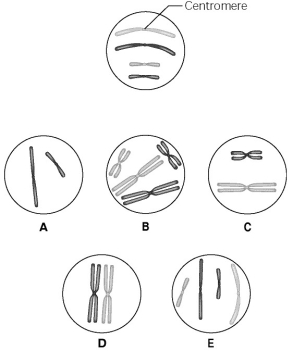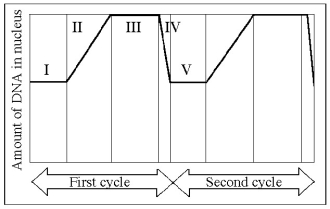A) cell membrane synthesis
B) spindle fiber formation
C) nuclear envelope breakdown
D) formation of telophase nuclei
E) synthesis of chromatids
Correct Answer

verified
Correct Answer
verified
Multiple Choice
Use the following information to answer the questions below.
The lettered circle in Figure 12.1 shows a diploid nucleus with four chromosomes. There are two pairs of homologous chromosomes, one long and the other short. One haploid set is symbolized as black and the other haploid set is gray. The chromosomes in the unlettered circle have not yet replicated. Choose the correct chromosomal conditions for the following stages.
 Figure 12.1
-What is the correct chromosomal condition at the prometaphase of mitosis?
Figure 12.1
-What is the correct chromosomal condition at the prometaphase of mitosis?
A) A
B) B
C) C
D) D
E) E
Correct Answer

verified
Correct Answer
verified
Multiple Choice
For a chemotherapeutic drug to be useful for treating cancer cells, which of the following is most desirable?
A) It is safe enough to limit all apoptosis.
B) It does not alter metabolically active cells.
C) It only attacks cells that are density dependent.
D) It interferes with cells entering G₀.
E) It interferes with rapidly dividing cells.
Correct Answer

verified
Correct Answer
verified
Multiple Choice
A group of cells is assayed for DNA content immediately following mitosis and is found to have an average of 8 picograms of DNA per nucleus. How many picograms would be found at the end of S and the end of G₂?
A) 8; 8
B) 8; 16
C) 16; 8
D) 16; 16
E) 12; 16
Correct Answer

verified
Correct Answer
verified
Multiple Choice
Proteins that are involved in the regulation of the cell cycle, and that show fluctuations in concentration during the cell cycle, are called
A) ATPases.
B) kinetochores.
C) kinases.
D) proton pumps.
E) cyclins.
Correct Answer

verified
Correct Answer
verified
Multiple Choice
Which of the following does not occur during mitosis?
A) condensation of the chromosomes
B) replication of the DNA
C) separation of sister chromatids
D) spindle formation
E) separation of the spindle poles
Correct Answer

verified
Correct Answer
verified
Multiple Choice
What causes the decrease in the amount of cyclin at a specific point in the cell cycle?
A) an increase in production once the restriction point is passed
B) the cascade of increased production once its protein is phosphorylated by Cdk
C) the changing ratio of cytoplasm to genome
D) its destruction by a process initiated by the activity of its complex with a cyclin
E) the binding of PDGF to receptors on the cell surface
Correct Answer

verified
Correct Answer
verified
Multiple Choice
What is a cleavage furrow?
A) a ring of vesicles forming a cell plate
B) the separation of divided prokaryotes
C) a groove in the plasma membrane between daughter nuclei
D) the metaphase plate where chromosomes attach to the spindle
E) the space that is created between two chromatids during anaphase
Correct Answer

verified
Correct Answer
verified
Multiple Choice
Suppose a biologist can separate one of a dozen pieces of chromatin from a eukaryotic (animal) nucleus. It might consist of which of the following?
A) one-twelfth of the genes of the organism
B) two chromosomes, each with six chromatids
C) a single circular piece of DNA
D) two long strands of DNA plus proteins
E) two chromatids attached together at a centromere
Correct Answer

verified
Correct Answer
verified
Multiple Choice
A mutation results in a cell that no longer produces a normal protein kinase for the M phase checkpoint. Which of the following would likely be the immediate result of this mutation?
A) The cell would prematurely enter anaphase.
B) The cell would never leave metaphase.
C) The cell would never enter metaphase.
D) The cell would never enter prophase.
E) The cell would undergo normal mitosis, but fail to enter the next G₁ phase.
Correct Answer

verified
Correct Answer
verified
Multiple Choice
Use the following information to answer the questions below. A student is looking through his light microscope (~450 X) at a squashed and stained onion root tip. Some, but not all, of the cells have clearly visible chromosome strands. -When the cell has just completed telophase, which of the following does he see?
A) a clear area in the center of the cell
B) chromosomes clustered at the poles
C) individual chromatids separating
D) formation of vesicles at the midline
E) two small cells with chromatin
Correct Answer

verified
Correct Answer
verified
Multiple Choice
Use the following information to answer the questions below.
The lettered circle in Figure 12.1 shows a diploid nucleus with four chromosomes. There are two pairs of homologous chromosomes, one long and the other short. One haploid set is symbolized as black and the other haploid set is gray. The chromosomes in the unlettered circle have not yet replicated. Choose the correct chromosomal conditions for the following stages.
 Figure 12.1
-What is the correct chromosomal condition for one daughter nucleus at telophase of mitosis?
Figure 12.1
-What is the correct chromosomal condition for one daughter nucleus at telophase of mitosis?
A) A
B) B
C) C
D) D
E) E
Correct Answer

verified
Correct Answer
verified
Multiple Choice
For a newly evolving protist, what would be the advantage of using eukaryote-like cell division rather than binary fission?
A) Binary fission would not allow for the formation of new organisms.
B) Cell division would allow for the orderly and efficient segregation of multiple linear chromosomes.
C) Cell division would be faster than binary fission.
D) Cell division allows for lower rates of error per chromosome replication.
E) Binary fission would not allow the organism to have complex cells.
Correct Answer

verified
Correct Answer
verified
Multiple Choice
A research team began a study of a cultured cell line. Their preliminary observations showed them that the cell line did not exhibit either density-dependent inhibition or anchorage dependence. What could they conclude right away?
A) The cells originated in the nervous system.
B) The cells are unable to form spindle microtubules.
C) They have altered series of cell cycle phases.
D) The cells show characteristics of tumors.
E) They were originally derived from an elderly organism.
Correct Answer

verified
Correct Answer
verified
Multiple Choice
Movement of the chromosomes during anaphase would be most affected by a drug that
A) reduces cyclin concentrations.
B) increases cyclin concentrations.
C) prevents elongation of microtubules.
D) prevents shortening of microtubules.
E) prevents attachment of the microtubules to the kinetochore.
Correct Answer

verified
Correct Answer
verified
Multiple Choice
The following questions are based on Figure 12.3.
 Figure 12.3
-In the figure above, mitosis is represented by which numbered part(s) of the cycle?
Figure 12.3
-In the figure above, mitosis is represented by which numbered part(s) of the cycle?
A) I
B) II
C) III
D) IV
E) V
Correct Answer

verified
Correct Answer
verified
Multiple Choice
Which of the following most accurately describes a cyclin?
A) It is present in similar concentrations throughout the cell cycle.
B) It is activated to phosphorylate by complexing with a Cdk.
C) It decreases in concentration when MPF activity increases.
D) It activates a Cdk molecule when it is in sufficient concentration.
E) It activates a Cdk when its concentration is decreased.
Correct Answer

verified
Correct Answer
verified
Multiple Choice
Besides the ability of some cancer cells to overproliferate, what else could logically result in a tumor?
A) metastasis
B) changes in the order of cell cycle stages
C) lack of appropriate cell death
D) inability to form spindles
E) inability of chromosomes to meet at the metaphase plate
Correct Answer

verified
Correct Answer
verified
Multiple Choice
The following information applies to the questions below. Several organisms, primarily protists, have what are called intermediate mitotic organization. -What is the most probable hypothesis about these intermediate forms of cell division?
A) They represent a form of cell reproduction which must have evolved completely separately from those of other organisms.
B) They demonstrate that these species are not closely related to any of the other protists and may well be a different kingdom.
C) They rely on totally different proteins for the processes they undergo.
D) They may be more closely related to plant forms that also have unusual mitosis.
E) They show some but not all of the evolutionary steps toward complete mitosis.
Correct Answer

verified
Correct Answer
verified
Multiple Choice
One difference between cancer cells and normal cells is that cancer cells
A) are unable to synthesize DNA.
B) are arrested at the S phase of the cell cycle.
C) continue to divide even when they are tightly packed together.
D) cannot function properly because they are affected by density-dependent inhibition.
E) are always in the M phase of the cell cycle.
Correct Answer

verified
Correct Answer
verified
Showing 41 - 60 of 79
Related Exams